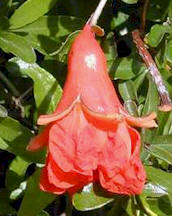|
This symbol denotes a disease resistant variety
FRUIT LIST LINKS
|
POMEGRANATES
The plant nursery has closed for retirement. We thank you for your pratronage through the last 26 years. Bill Ford is available for consultation and presentations. Please feel free to use the following pages for reference. Happy gardening! ANGEL RED
AUSTIN
GRENADA
WONDERFUL
"Let us go early to the vineyards to see if the vines have budded, if their blossoms have opened, and if the pomegranates are in bloom— there I will give you my love." Song of Solomon 7:12 (NIV)
Planting Information
The pomegranate fruit has been enjoyed for many centuries by the Chinese, Indians, Persians, Greeks, Mediterranean Europeans and Egyptians, making warriors invincible and offering a long and healthy life. High in disease-fighting antioxidants, Vitamin C, potassium and niacin, pomegranate juice has been used to treat inflammation, sore throats, and rheumatism. The seeds with the juicy translucent scarlet red pulp are edible parts of the fruit. The flavor is delicate, sweet, and tangy.
These hardy plants can grow into a 15-20 ft tree if allowed, but most owners keep their plants down to a 6-8 ft bushy shrub for easier access. Their high drought tolerance allows for less water needed once established, though water at least weekly for better fruit production. All varieties are self-pollinating. Plant in full sun. Zones 8-10.
"Your plants are an orchard of pomegranates with choice fruits," Song of Solomon 4:13 (NIV)
|
|
